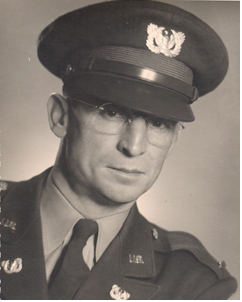Chief Warrant Officer 4
Grayford C. Payne
 Grayford Payne
was born near Dallas, TX on 21 September 1919. He joined the New Mexico National Guard in 1939. In 1941, his unit,
the 200th Coast Artillery (Anti-Aircraft), was deployed to Fort Stotsenburg in the Philippine Islands. After the
landing of Japanese troops in the Philippine Islands, Payne conducted nighttime combat and scout missions behind
Japanese lines in order to find artillery positions, troop concentrations and ammunition storage areas.
Grayford Payne
was born near Dallas, TX on 21 September 1919. He joined the New Mexico National Guard in 1939. In 1941, his unit,
the 200th Coast Artillery (Anti-Aircraft), was deployed to Fort Stotsenburg in the Philippine Islands. After the
landing of Japanese troops in the Philippine Islands, Payne conducted nighttime combat and scout missions behind
Japanese lines in order to find artillery positions, troop concentrations and ammunition storage areas.
On the night of April 8, 1942, a Colonel greeted him and told him 'Lieutenant, we are preparing to surrender Bataan. We have to get the wounded and whatever we can to Corregidor. Your platoon is to hold the road at all cost, you will have to die on your guns. We have prepared you a fighting position to block the road, there is a column of Japanese tanks several miles down the road and infantry is breaking through trying to cut our retreat.' Payne took his remaining 14 soldiers and occupied their positions. Their next task was to collect large stones and bury them in the road. It was not long after they had buried the last stone that they heard, and then saw, a column of Japanese tanks on the jungle road. However, the sloppy job of 'mining' worked, the tanks stopped. Payne ordered his soldiers to shoot only a few rounds at the tank to keep the gunner inside the turret. This trick worked for over an hour. Finally, they saw the Japanese infantry crossing the road several hundred meters behind their position. Payne told his men he would try to surrender if possible, but he did not know if the Japanese would accept. For those who wished to escape in the jungle, he told them to do so now. All agreed they would stick together. CWO4 Payne got a white handkerchief, held it above his head and slowly climbed out to the trench. After clearing the 'mines', as the Japanese officer insisted, the remaining soldiers surrendered. April 9, 1942 was the beginning of 3 years, 5 months and 20 days in 5 Japanese POW camps, the Bataan Death March, a voyage on the 'Hell Ships' to Japan and internment as slave labor.
There are numerous stories of Payne's selflessness. When he could steal, he rarely kept anything for himself. Stolen food was to be used to nurse the sick back to health. The Japanese treatment of the sick was far worse than those prisoners who could work. In one of his most memorable acts, he switched his uniform with another who had been seen stealing. During the ensuing muster, the Japanese guard could not confirm the identity of the man who wore the uniform of the soldier who stole the food. Ultimately, it resulted in the beating of the Japanese guard by a Japanese officer for his inability to confirm the identity of the thief. After the war, Payne was recognized for this specific act by his fellow POWs. They requested he be awarded the nation's highest medal, but it was determined that what he did was an act of humanitarianism not an act of valor.
After liberation and extended hospital stays in the United States, Payne applied to be a Warrant Officer and was accepted as both a Maintenance and an Ammunition Warrant Officer. His battlefield commission, given to him before captivity, had been revoked due to a lack of documentation. Payne's next assignment was on the 2nd Army staff at FT Meade, MD.
Following duty in the Korean War, he was stationed in Germany, Sierra Army Depot, Okinawa, Japan, and Camp Darby, Italy. Payne deployed to Vietnam in 1966 and worked on the Ready Assist Teams as a part of U.S. Army Vietnam (USARV). He travelled all over Vietnam assisting units resolve a myriad of logistics issues ranging from accountability issues to determining why a howitzer had a pre-detonation in the breech to studying ammunition jamming in the M16 Rifle.
Upon retirement in 1968, an old POW friend of his, U.S. Army Chief of Staff General Harold K. Johnson called Payne and wished him well. Grayford Payne died on 1 May 1998.